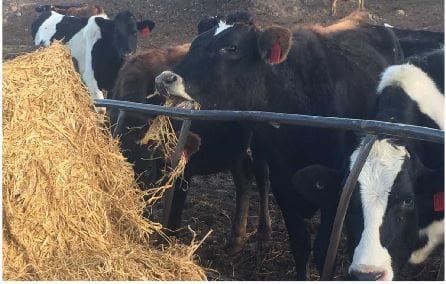PROLONGED drought conditions have focused a lot of attention on traditional fodder sources. Strong demand, dwindling supply and elevated prices have forced many livestock growers to consider alternative feed sources that they would not usually feed to their stock as traditional feeds, such as cereal hay, becomes harder to source or too costly to purchase in volumes sought. Rice straw can be an economically viable feed source during drought when harvested and treated under optimal conditions.

Dairy cattle on rice straw. Photo: Ash Dempster.
Traditionally rice straw has been considered a waste or by-product of growing rice, often being burnt in order to prepare for the next crop. The practice of burning rice straw is becoming environmentally unacceptable; hence many rice farmers are now seeking out more environmentally sustainable options to remove the straw from their paddocks that is also offering another source of income from their crop.
Rice straw can be a very economical feed option in the livestock grower’s toolbox if conserved properly and used wisely as a part of a feed ration. While it must be noted that rice straw is the lowest nutritional value form of straw available, not all rice straws are equal. There can be some very big differences in the quality of rice straw solely due to the timing of when the straw is harvested and baled. The sooner the rice straw is cut behind the header, the better the quality of the final product.
Ideally rice straw should be harvested between three to 10 days, post stripping with the header. It must still be green when cut. If it has browned off and dried out, livestock will refuse it as it is too dry and will have almost no feed value at all. The greener the rice straw, the better the quality, which is a direct reflection of the moisture content of the plant at cutting.
It must be noted that rice straw is too low in energy and protein values to ever be a complete ration for any livestock, no matter how early it is cut or conserved. During drought, it can be useful and economical to form part of livestock ration.
Gassing rice straw, using anhydrous ammonia gas, has proven to significantly increase the quality of rice straw as a livestock feed source. Untreated, dry rice straw will usually record a protein of around 3-4% but after appropriate treatment with anhydrous ammonia gas, protein can lift to between 8-9 per cent. Digestibility and energy also increase as a result of the gassing process.
Goulburn Valley dairy
In Victoria’s Goulburn Valley, Shepparton dairy farmer Ashley Dempster has recently finished baling and preparing over 5000 rice straw bales from Coleambally in NSW with anhydrous ammonia. Back on his dairy farm, Ash has no doubt on the value of the rice straw as a supplementary feed source for his dairy cattle.
“The proof of the pudding is always in the eating and my cows are enjoying this rice straw” Ash said.
“When traditional sources of hay are in short supply you must think about other options, and I looked at rice straw, did my homework and figured it was worth having a go at it.
“Using the anhydrous ammonia gas on the rice straw turns a relatively low value feed source into something of value to all livestock producers, be they dairy or beef.
“I believe this is something we can do more of and I would encourage others close to rice growing regions to look at making rice straw too. ”
Source: AFIA
A Fodder Brief two-page fact sheet about using rice straw has been prepared by the Australian Fodder Industry Association (AFIA) and is available for download, click here.

HAVE YOUR SAY